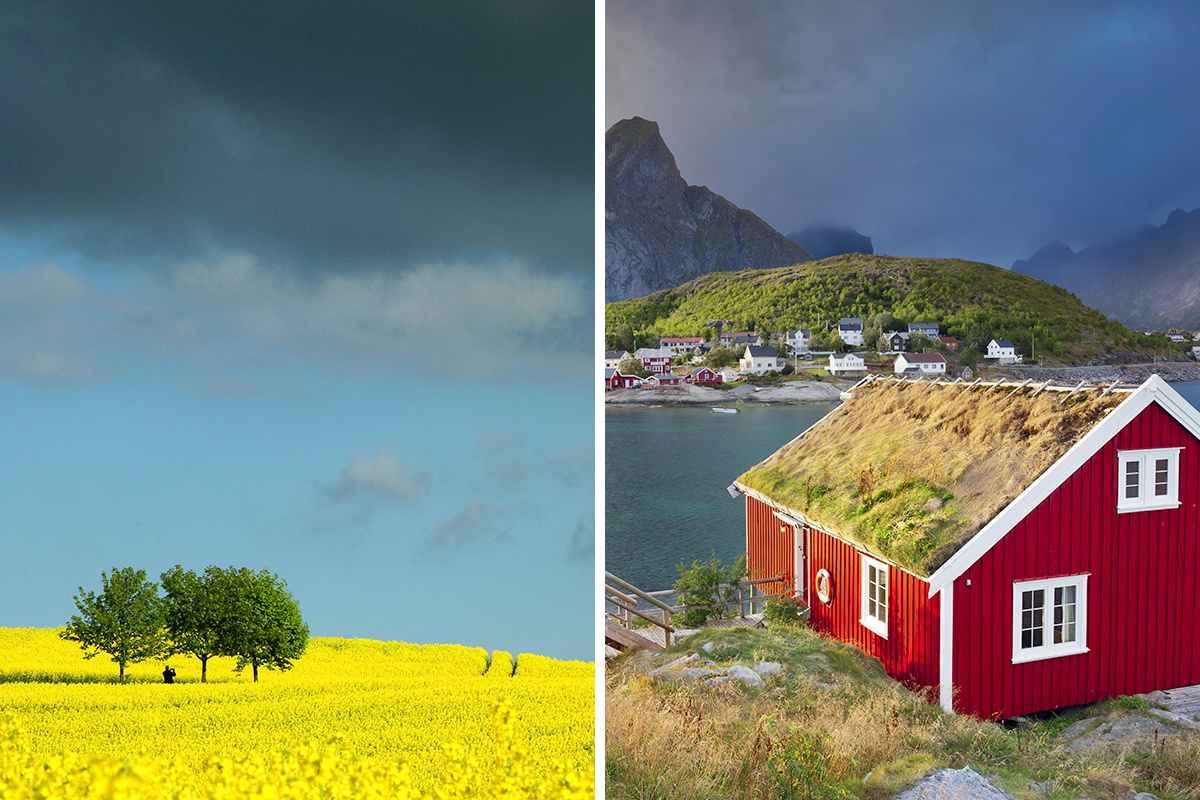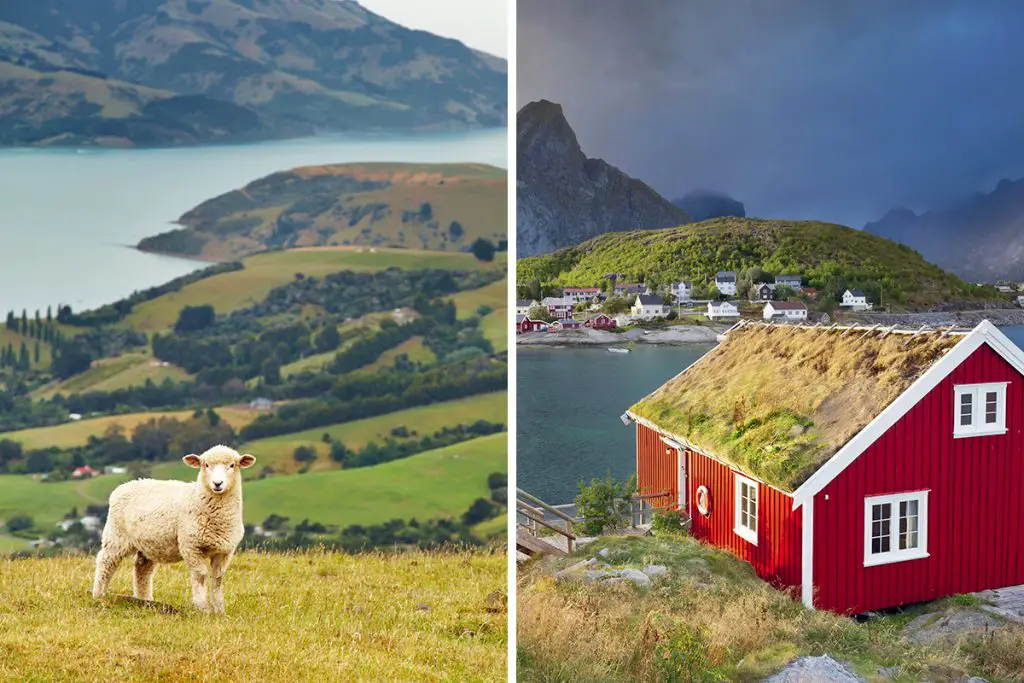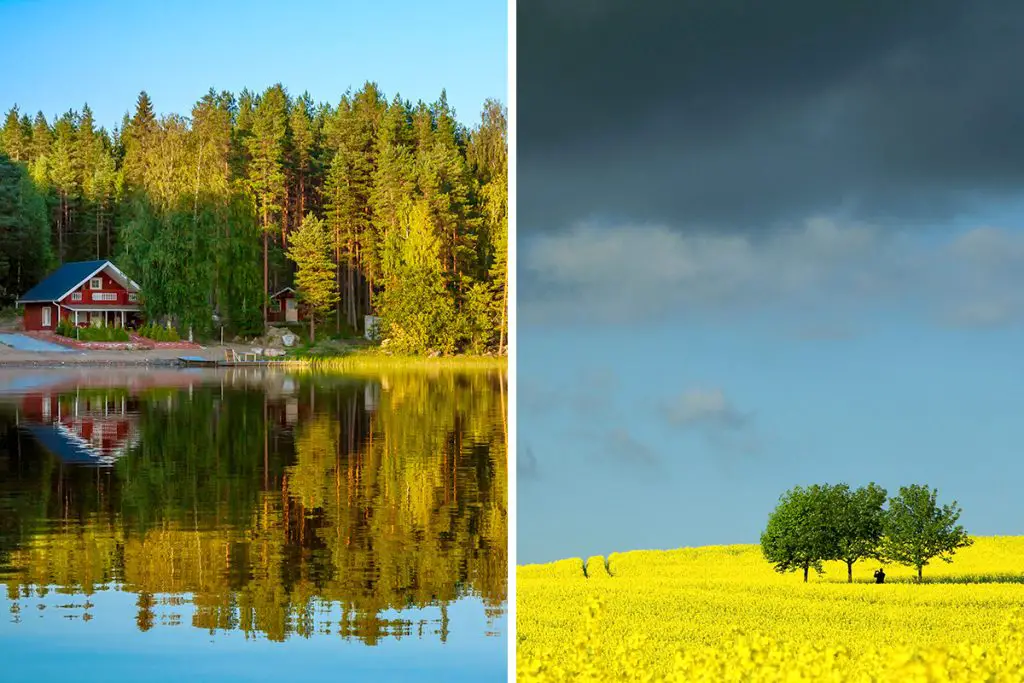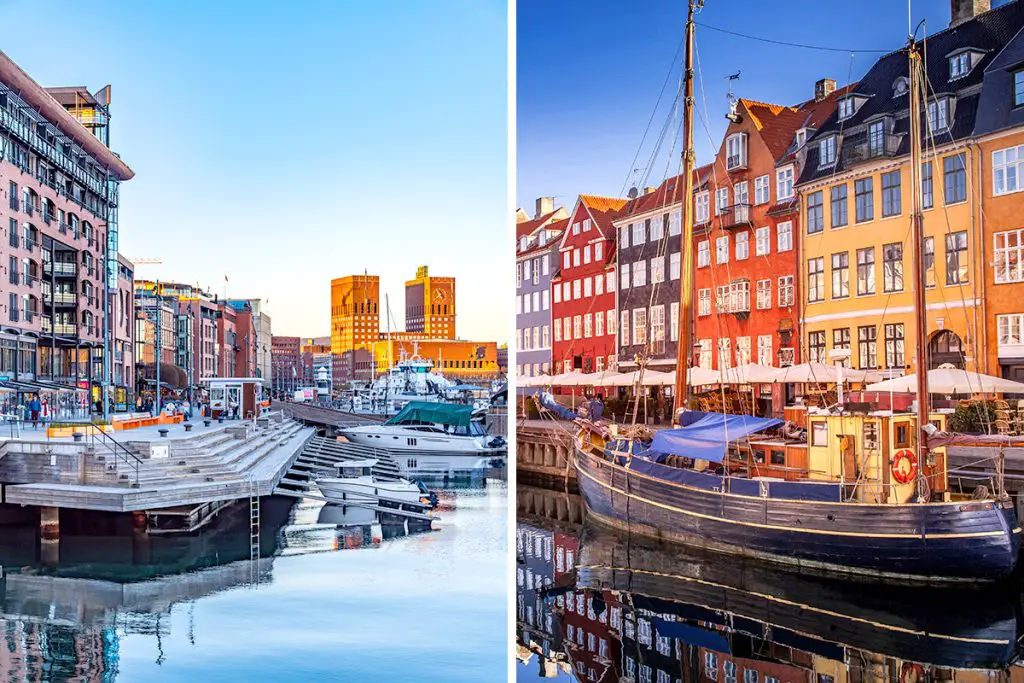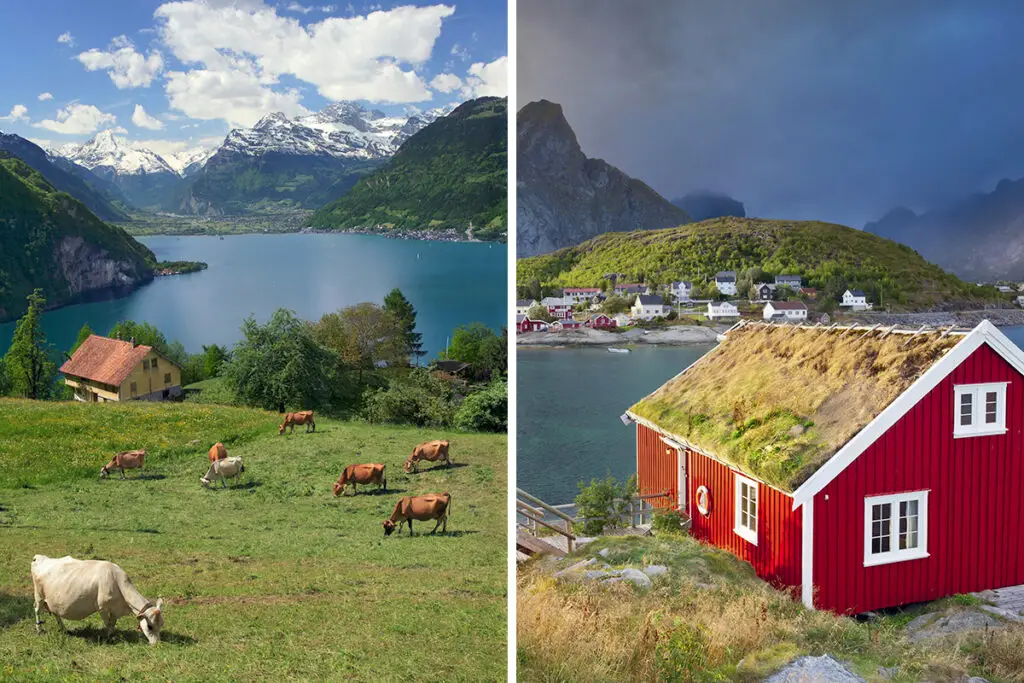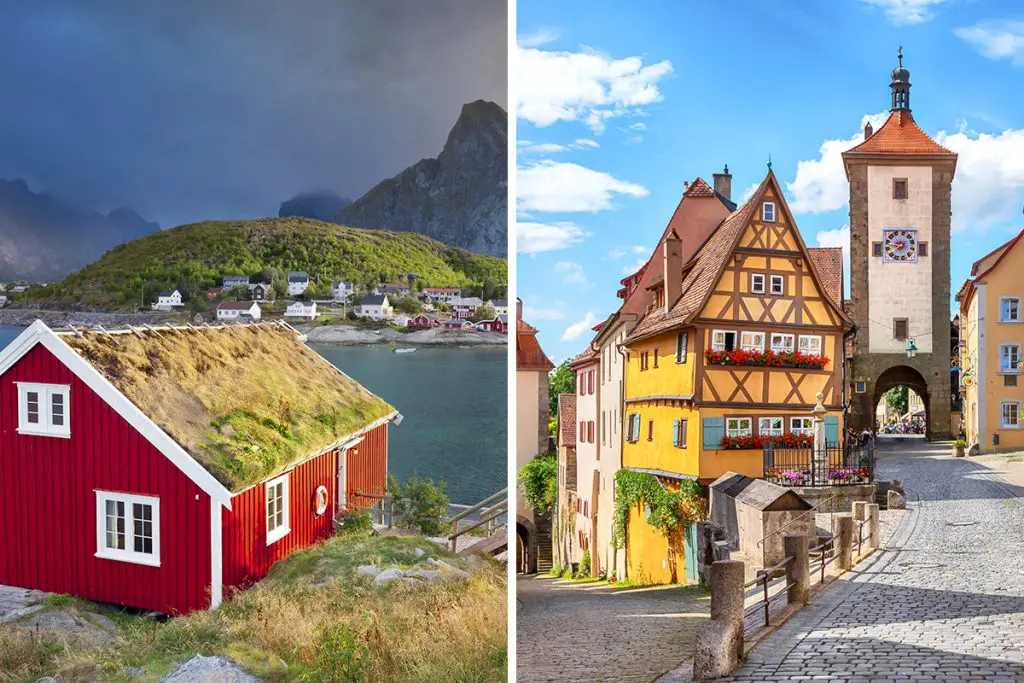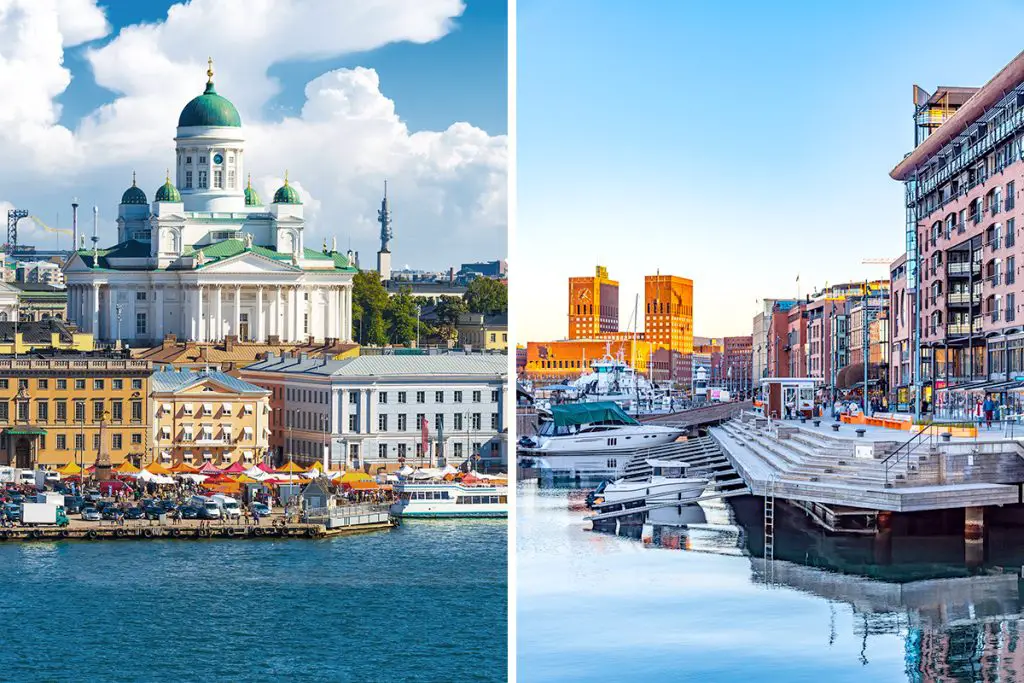Denmark and Norway, two jewels of Scandinavia, have something for every traveler. With their captivating cultures, breathtaking natural beauty, and the allure of adventure, your journey is bound to be unforgettable. Ready to discover what these Scandinavian paradises have in store for you? Read on and let your Nordic journey begin.
History & Culture
Have you ever wondered about the past and traditions of Denmark and Norway? They are like two books filled with interesting tales. Let’s turn their pages!
In Denmark, your journey back in time starts with the Vikings. Yes, those brave seafarers came from here! They left their mark with stunning artifacts and tales of daring adventures. Fast forward to the Renaissance, and you find Denmark thriving as a naval power. The Danes have a thing for fairy tales too. Ever heard of Hans Christian Andersen? That’s their pride!
Norway, on the other hand, shares the Viking heritage. But its history takes a twist with a stronger focus on farming and fishing communities. It also had its share of naval prowess, especially during the Age of Vikings. Norway’s cultural identity is tied up in its love for nature. They have a deep respect for the land, which is seen in their folklore and traditions.
Danes are known for their love of ‘hygge’, a concept that’s all about coziness and comfort. They value simplicity and contentment. You’ll notice this in their lifestyle and social interactions. It’s a big part of why Denmark often ranks as one of the happiest countries in the world!
Norwegians also cherish simplicity, but in a different way. They call it ‘koselig’. It’s a bit like ‘hygge’, but with more emphasis on enjoying the outdoors, even in cold weather. You’ll see this love for nature reflected in their traditions and everyday life.
So, in the culture and history contest between Denmark and Norway, it’s not about who wins. It’s about the unique flavor each country brings. Will it be Denmark’s seafaring past and ‘hygge’ lifestyle or Norway’s nature-loving culture and ‘koselig’ concept that appeals to you more?
Attractions & Activities
Denmark and Norway are both full of things to see and do. Let’s take a look at what these two Scandinavian gems have to offer!
In Denmark, you can’t miss visiting Copenhagen, the capital city. The iconic Little Mermaid statue and the colorful buildings of Nyhavn are must-sees. For history buffs, the National Museum of Denmark is a treasure trove. Love castles? Then, you’ll be thrilled by the Renaissance-era Kronborg Castle.
Norway, on the other hand, offers breathtaking natural attractions. The famous fjords, like Geirangerfjord and Nærøyfjord, are truly awe-inspiring. If you’re up for a thrill, try hiking to Pulpit Rock for a view you’ll never forget. Oslo, the capital city, is home to the Viking Ship Museum, a nod to Norway’s rich history.
Copenhagen also offers a lot of green spaces. You can relax in the beautiful King’s Garden or visit the Copenhagen Zoo. For a unique experience, try a canal tour around the city.
Norway’s activities are more focused on nature. You can go on a fjord cruise or try cross-country skiing. For a touch of culture, visit the outdoor Norsk Folkemuseum in Oslo.
In summary, if you love cityscapes and history, Denmark might be your go-to place. But if you prefer nature and outdoor activities, Norway could be your perfect fit. So, which one tickles your fancy, the historical charm of Denmark or the natural beauty of Norway?
Beaches
The beaches of Denmark and Norway? Ah, each one is a little slice of heaven. Let’s dive into the sandy shores and crisp waters of these Scandinavian gems.
Denmark is flat and surrounded by seas, so it has plenty of beaches. One favorite is Skagen’s Sønderstrand. It’s in the north, where two seas meet. You can literally stand with one foot in each sea! The beach is long, about 60 miles (around 96.5 kilometers), and is known for its soft sand and light.
Amager Beach in Copenhagen is another Danish gem. It’s a man-made island stretching about 2 miles (around 3.2 kilometers). Perfect for a city break, right? You’ll find white sands and a view of the Øresund Bridge, linking Denmark and Sweden.
Norway, famous for its fjords, isn’t known for beaches, but it has some hidden gems. Huk Beach, near Oslo, is small but beautiful. It’s about 0.6 miles (roughly 1 kilometer) long, and it offers lovely views of the fjord.
Kvalvika Beach in the Lofoten Islands is another Norwegian beauty. It’s hidden between mountains and can only be reached by a 1.2-mile (around 2 kilometers) hike. The effort is worth it, trust me! The view of the turquoise sea against the rugged mountains is just breathtaking.
In conclusion, Denmark’s beaches are easily accessible and family-friendly, while Norway’s are more secluded and adventurous. Are you looking for convenience and city views, or are you up for a little adventure with stunning nature?
Eating, Drinking & Nightlife
Now, let’s talk about the fun stuff: food, drinks, and nightlife in Denmark and Norway. Are you ready for a culinary and entertainment journey?
Danish cuisine is all about simplicity and freshness. Smørrebrød, an open-faced sandwich, is a must-try. For a sweet treat, try Danish pastries. They’re flaky, buttery, and absolutely delicious.
When it comes to drinks in Denmark, Carlsberg beer is quite popular. If you’re brave, try snaps, a strong Danish liquor often enjoyed with meals. It’s definitely an experience!
Copenhagen is known for its vibrant nightlife. There are jazz clubs, dance clubs, and cozy pubs. If you’re into live music, check out VEGA, one of the city’s top concert venues.
Now, let’s head over to Norway. Norwegian cuisine is heavily influenced by its coastline. Fresh seafood is a must. Try Rakfisk, a traditional dish of fermented fish, if you’re feeling adventurous!
Norwegians love their coffee. They’re one of the top coffee-consuming countries in the world. So, grab a cup and enjoy. For something stronger, try Aquavit, a spiced spirit that’s a favorite in Norway.
Nightlife in Norway is diverse. Oslo has everything from high-end clubs to local pubs. If you’re in the mood for a show, check out the National Theatre in Oslo.
In summary, Denmark offers classic dishes, strong drinks, and a lively music scene, while Norway brings fresh seafood, unique coffee culture, and a diverse nightlife to the table. So, are you leaning towards Danish comfort food and lively clubs, or does Norwegian seafood and a cup of rich coffee sound more appealing?
Shopping
Denmark and Norway are both shopping heavens, each in their own unique way. Ready to fill up your shopping bags?
In Denmark, Copenhagen’s Strøget is a must-visit. It’s one of the longest pedestrian streets in Europe, full of shops. You can find big brands and Danish designers all in one place.
For a more local experience, Torvehallerne in Copenhagen is a treat. It’s a market where you can buy fresh food, flowers, and Danish delicacies. If you’re a book lover, check out the charming secondhand bookshops around the city.
Norway also offers a wonderful shopping experience. Oslo’s Karl Johans Gate is the main shopping street. It’s lined with shops, from high-end brands to local Norwegian designs.
In Bergen, you’ll find the famous Fish Market. Besides fresh seafood, it also sells crafts and souvenirs. If you’re into vintage stuff, Oslo’s Grunerløkka district has cool secondhand shops and indie boutiques.
In a nutshell, Denmark offers a blend of modern and traditional shopping, while Norway provides a mix of high-end and local shopping experiences. So, are you excited to shop for Danish designs or would you rather explore Norwegian boutiques?
Accommodation
Finding a place to stay in Denmark and Norway is easy, with lots of options to suit your style. Let’s find the perfect one for you!
In Denmark, Copenhagen offers luxury hotels with stunning views of the city. You can also find budget-friendly hostels that are cozy and clean.
For a unique Danish experience, try staying in a holiday cottage. They’re popular in coastal towns and offer a home-like comfort.
In Norway, Oslo has a range of hotels from luxury to budget. Many are located near popular attractions, making sightseeing a breeze.
You can also try cabin stays in Norway. They’re especially popular in the countryside and offer stunning views of the natural landscape.
To sum it up, Denmark offers everything from luxury hotels to cozy cottages, while Norway has a range of hotels and unique cabin stays. So, are you dreaming of a luxury hotel in Denmark’s capital or a cozy cabin in the Norwegian countryside?
Family-Friendliness & Children’s Activities
Traveling with kids? Both Denmark and Norway roll out the red carpet for families. Let’s see what they offer!
In Denmark, Tivoli Gardens in Copenhagen is a hit with kids. It’s an amusement park right in the city center. It has fun rides, games, and even live performances.
Another great Danish spot is the National Aquarium, also known as Den Blå Planet. It’s Northern Europe’s largest aquarium, full of fascinating sea creatures.
Norway is also family-friendly. The Norwegian Museum of Science and Technology in Oslo is fun and educational. Kids can learn about science and technology through interactive exhibits.
Another Norwegian highlight is the Kristiansand Zoo and Amusement Park. It’s the most visited attraction for families with children in Norway. It offers a zoo, a water park, and even a pirate village!
In short, Denmark offers city-based family attractions, while Norway provides a mix of educational and outdoor fun. So, are you thinking about a thrilling amusement park ride in Denmark or an educational adventure in Norway?
Getting There & Getting Around
Wondering how to reach and navigate Denmark and Norway? Both countries offer convenient options, making your journey smooth and enjoyable.
To reach Denmark, Copenhagen Airport is the main international gateway. It’s about 5 miles (8 kilometers) from the city center. Many airlines operate flights to Copenhagen from major cities around the world.
Once in Denmark, getting around is easy. The country has an efficient public transportation system. Trains and buses connect cities and towns. Bicycling is also popular in Danish cities.
Norway is also accessible by air. Oslo Airport is the largest, around 22 miles (35 kilometers) from the city. Like Denmark, many airlines fly to Norway from international destinations.
Getting around in Norway is best done by public transport. Trains, buses, and ferries connect different parts of the country. For city travel, Oslo has trams and buses.
To conclude, both Denmark and Norway are easy to reach and navigate. Denmark offers efficient public transport and bike-friendly cities, while Norway’s public transport provides easy access to its scenic landscapes. So, are you ready to hop on a Danish bike or explore Norway’s scenic routes by train?
Weather
Curious about the weather in Denmark and Norway? Let’s dive in!
Denmark has a temperate oceanic climate. Summers are pleasant, with temperatures around 68°F (20°C). It’s perfect for outdoor activities.
Winters in Denmark can be chilly. Temperatures drop to around 32°F (0°C). But don’t worry, it’s still a good time to visit, especially if you like cozy indoor activities.
Norway’s weather varies with its geography. Coastal areas have milder winters and cooler summers. Summer temperatures are around 60°F (15°C), while winter temperatures hover around 30°F (-1°C).
Inland Norway, especially the mountainous areas, can get much colder. In winter, temperatures can drop to -4°F (-20°C).
To sum up, Denmark’s weather is mild and stable, while Norway offers a range of climates depending on where you are. So, are you up for a mild Danish summer or would you prefer a cool Norwegian one?
Safety
Concerned about safety while traveling? Both Denmark and Norway are known for being safe.
In Denmark, crime rates are low. Petty crime like pickpocketing can occur, especially in tourist areas. But by staying alert, you should be fine.
Norway is also considered safe. It shares the same concern of petty crime in crowded places. Just like in Denmark, keep an eye on your belongings.
Unique to Norway, you should be aware of natural hazards. If you’re hiking in the mountains, remember that the weather can change rapidly.
Summing it up, both Denmark and Norway are safe destinations with low crime rates. Just remember to be aware of your surroundings. So, are you ready to explore Denmark’s safe streets or venture into Norway’s safe but wild outdoors?
Cost
Wondering about the costs in Denmark and Norway? Let’s find out!
In Denmark, the local currency is the Danish Krone (DKK). A meal at an inexpensive restaurant costs around 120 DKK (about 19 USD). Transportation is also reasonable, with a one-way ticket on local transport costing around 24 DKK (roughly 4 USD).
Accommodations in Denmark can vary. Budget options start from 400 DKK (approximately 63 USD) per night. More luxury stays will, of course, cost more.
Norway uses the Norwegian Krone (NOK). It’s known for being one of the more expensive European destinations. A meal at a budget-friendly restaurant might set you back about 200 NOK (23 USD). A one-way ticket on local transport is about 36 NOK (4 USD).
Accommodation prices in Norway are similar to Denmark. You can find budget options from 600 NOK (70 USD) per night. Luxury accommodations will cost more.
In conclusion, both Denmark and Norway can be pricey compared to other destinations. However, with careful planning, affordable options are available. So, are you ready for the Danish value or the Norwegian experience?
Which Is Better – Denmark or Norway?
Making a choice between Denmark and Norway isn’t easy. Both countries have a lot to offer.
History and culture enthusiasts might lean towards Denmark. Its rich Viking history and cultural sights like Tivoli Gardens and the National Aquarium make it a standout.
If attractions and activities are your thing, both countries have their merits. Denmark has city-based fun, while Norway offers outdoor and educational experiences.
For beach lovers, the choice might hinge on personal preference. Norway’s fjord beaches are unique, while Denmark’s sandy beaches are more traditional.
Foodies and night owls might prefer Denmark for its world-renowned cuisine and vibrant nightlife. Norway, on the other hand, offers unique culinary experiences and a more laid-back night scene.
When it comes to safety, both countries are considered safe. However, remember to stay alert, especially in crowded tourist areas.
Ultimately, your choice between Denmark and Norway will depend on what you’re seeking from your trip. Are you ready to make your pick?

